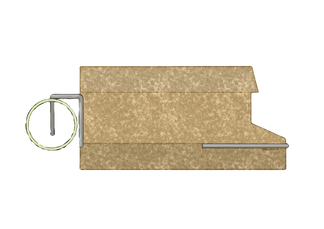
2023
Hôte
A system using existing infrastructure to accommodate migratory bird populations at their stopover sites.
Photoshop
InDesign
Illustrator
Autodesk Fusion 360
Workshop
Final Major Project
Featured in
LSBU's 2023 Degree Show
New Designers 2023
Deezen Magazine
Table of contents
Cerulean Warbler
Blackpoll Warbler
This product is currently tailored to
Vulnerable:
63% population decline between 1966 and 2019
Population decreasing :
71% population decline between 1966 and 2019

Cerulean and Blackpoll Warbler migration
Breeding in North America
Nonbreeding in South America
Autumn migration: USA to South America
Spring migration: South America to North America
Stopover sites:
Eastern coast of the United States
Northern coast of Venezuela
Key Features
Inspired by the naturally occurring strong lattice shape adopted by bees, the hexagonal shape of each room enables for easy stacking and aligning during assembly.
The inside of the product is intended to mimic holes created by certain species that burrow underground, whether it be for tunnelling away from predators, or steering clear from harsh weather conditions.
Irregular shape of the room allows birds to bring in twigs, brambles or even moss to make their stay more enjoyable.
The cork material is lightweight, works efficiently in high temperatures and humidity, and crucially, fire resistant, making it appropriate for use on the side of buildings.
Manufacturing-wise, this material would be compression moulded with tree seeds, to enable meaningful end-of-life of the product.
Each room is fitted with a camera, triggered by a proximity sensor for wildlife data collection, and monitoring for conservation efforts.
Meaningful end of life
Why it matters
68% of global average wildlife population sizes have declined between 1970 and 2016, with 94% in Latin America and the Caribbean.
Migratory bird populations specifically suffer from a number of factors, including:
Habitat loss, fragmentation or degradation,
Loss of land allocated to anthropogenic needs, such as agriculture and deforestation, fragmentation due to urban development or infrastructure, and degradation due to overexploitation are all factors that contribute to loss of wildlife populations.
Building collisions and disorientation caused by light pollution
Travelling pole wards requires bird populations to travel over cities, the lack of visibility causes birds to collide with buildings. Glass buildings cause issues in the daytime for birds, as they will try to fly through the glass if they see fragments of sky. Light pollution also generates disorientation from familiar landscapes, which causes them to get off-track, lost, and ultimately die from exhaustion.
Pesticides
Pesticides kill insects critical for the refuelling and survival of bird populations. New study also suggests this can also cause migratory birds to suffer from drastic weight loss and disorientation when exposed to the specific toxin found in pesticides.
The impact of climate change
Migration of animals requires continuous monitoring and is, at it's core, crucial for certain species to remain within their preferred elevation, whether it's for overwintering or breeding purposes. Rising temperatures will lead to a mass migration of species -- that have previously not displayed this type of behaviour -- in an attempt to survive. Behavioural changes have already been recorded, such as changes in diets and/or hunting techniques.
Cities are currently unsuited for this mass migration, focusing on accommodating rising population densities, which makes it unfit for welcoming wildlife.
To enable both to prosper in parallel, it is crucial to open cities to wildlife and assist their migrations, by creating wildlife corridors.
Long term, this proposal could improve physical and mental wellbeing of inhabitants, create cleaner air quality, and strengthen cities by making them more resilient to climate change.









